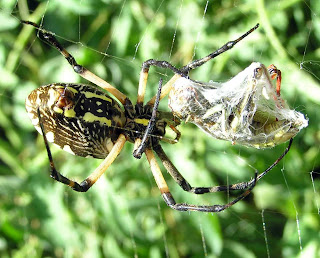 I'm told every gardener has at least one year like this... I imagine that's supposed to make me feel better as I look at this dismal forest of stalks and can hear the munching of gazillions of not-so-tiny mouths.
I'm told every gardener has at least one year like this... I imagine that's supposed to make me feel better as I look at this dismal forest of stalks and can hear the munching of gazillions of not-so-tiny mouths.Warnings of "don't waste your time this year" were abundant right from the beginning! Nothing seemed to come together easily... from the change to raised beds to the #@*#/! bugs in my seed storage bin, making store bought seed a necessity. The weather was capricious and seemed to have a malicious sense of humor, waiting patiently until each planting was the ideal size and tenderness to easily target with hail or unreasonably late freezes.
The fruit went first. Trees loaded with blooms and tiny peaches became barren wastelands of frozen branches and shriveled nubs of once future preserves, jams, jellies and succulent snacks.
My poor squash never sprouted at all. Peas made a valiant effort and supplied our table for a couple of pickings before hail took out most of them. Snow peas loved the cool weather and were going like gangbusters until a visiting puppy decided that lush half-barrel was just made for digging in. She had so much fun I couldn't even be terribly angry as I walked out the door to see her sitting and grinning proudly, covered in dirt with a mouth full of tasty greens, in the middle of the now half empty barrel. Blatant cuteness has saved many a life.

Sunflowers grew weird with multiple heads and small seed like they had crossbred with wild strains. Mind you, I purchased this seed (Grey Striped Giants) fresh. The flowers were a beautiful array of yellows and reds and brightened the mornings until those pretty little beetles arrived. Short work was made of my tall, svelte beauties before I even knew there was a problem afoot. Winter birds will have a lean time of it this year.

The corn knew better... it barely bothered to break ground. A handful of spindly stalks showed timid faces before the hail beat them to the ground. Late in the season, a few more tried their luck and almost made an ear or two before the final devastation arrived... grasshoppers.
It started with waves of movement as you walked across the yard. The cause of all this activity required close inspection to identify. I have never seen so many or such small grasshoppers in one place in all my life! I frantically put diatomaceous earth on everything without blooms. (Why without blooms? We had a bee colony move into a barrel on the property and I didn't want to risk killing them too.) Sevin dust came later, but even it made no dent in the horde. They grew in size and numbers until I simply gave up.

When people ask me what I am growing this year I sadly reply... grasshoppers... grasshoppers, crickets and spiders.

This year, I have seen grasshoppers and crickets that I have never noticed before! There are the usual assortment of red wing, brown stripe, iridescent blues and greens in abundance.

Now we have a solid black stealth grasshoppers and tons of gorgeous maroon colored crickets that I am told are Mormon Crickets. According to the USDA-ARS "The current upsurge of Mormon crickets in the western U.S. is one of the most severe infestations on record..."

With the explosion of food, the spiders have flourished! These are great giants that give old women and small children nightmares… Huge, fat creatures that I owe a debt of gratitude to for my only crop this year. They saved the tomatoes from the hoppers and sometimes they protect them even from me. It takes me an hour of dread before I can bring myself to approach the rank overgrowth that is my tomato patch. For two hours after a picking I am squeamish and jumpy, feeling crawly and watching for tiny offspring in clothing and hair. Intellectually, I know this is silly but instinct takes over and my skin is hyper-alert to the slightest touch or movement.

These babies have abdomens as big or bigger than the pad of my thumb! Webs stretch three and four feet across, catching even the largest grasshoppers with ease! They are Golden Orb Weavers or Banana spiders I am told by my Cajun hubby. (The egg sack pictured measures about one inch across!) Evidently, they are quite common in the swamps of Louisiana and I'd like to know what the heck they are doing out here in the desert! lol They might have been here, but I never saw anything like this growing up. Probably wouldn't have ever started gardening if I had!

Irrational fear aside, I have grown quite fond of my crop of spiders. I hope they stick around... just not too close... for next year's garden. I really dislike any form of pesticide and they are exceptionally efficient at their jobs.


Actually, I gained a new hobby from all this disappointment... bugs! They are fascinating. Many are stunningly beautiful and some are down right alien looking, like the preying mantis that found my camera interesting enough to stalk.

So, not all is lost and I have already planted my winter greens and am trying for some squash one more time, even though it is a bit late. If they come up I might be encouraged enough to build a couple of hot houses around them, providing frames that could become screened shelters against next year's crop of hoppers. Live and learn.






